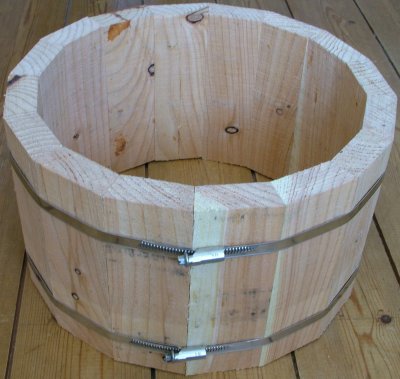
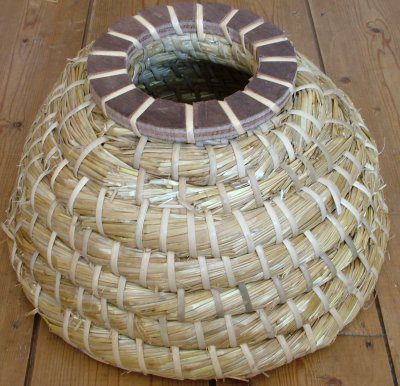
David Heaf's version of Claude Bralet's 'ruche sauvage' (wild hive)
(for Claude Bralet's original version, click here)
Construction
The box is in 30 mm thick local grown FSC certified larch with 75 mm outer width staves. The internal diameter between parallel faces is 315 mm. The intention is to secure the box entirely by the 370-390 mm stainless steel bands. The bands were bought from the seller 'agmimibu' at ebay.de (Edelstahl - Niro V2A Schlauchschelle 37 - 39 cm). The box height is 210 mm.


The dome was made by standard depriving skep-making technique starting with a 100 mm hole in the top. Rye straw was purchased from Inthatch. The plywood ring (150 m OD, 100 mm ID) was stitched on later with lapping cane running in grooves in the top surface. The cane (glossy, 5mm) was purchased from Fred Aldous Ltd. through Amazon. The ends of the grooves in the ring were rounded with a file to avoid taking the cane through a sharp right angle. In the centre of the ring is a comb support comprising a wooden hub and six 'spokes' of bamboo cane. The spokes are sharpened at the outer ends and pushed into the straw. The inner ends are inserted into holes drilled in the hub. The load-bearing capacity of the hub was tested by placing a 1 kg. weight on it. It did not visibly sag.
The top assembly, illustrated in the photo on the right immediately below, serves as a base for a feeder and offers a geometrically regular shape for mating to a super. The hub and spokes provide comb support while minimising occlusion of the 100 mm hole, thus giving the bees at least as much access to the space above the dome as in Claude Bralet's terracotta dome illustrated above. The intention was to minimise the cue given to the bees to start building comb in a particular direction, but rather allow them to determine the direction themselves.
The dome width is 340 mm OD and its height is 178 mm including the ring. The dome sits in a triangular notch in each stave, 12.5 mm deep and 38 mm long 40 mm from the bottom rim of the box (see photo of notched stave in Bralet's version above). As the dome was a tight fit in the box and there might have been a slight risk of damaging the thread of the steel bands while tightening, the final clamping of the staves was done with a heavy-duty ratchet strap and the band screws tightened to their final positions while the pressure of the strap was applied.
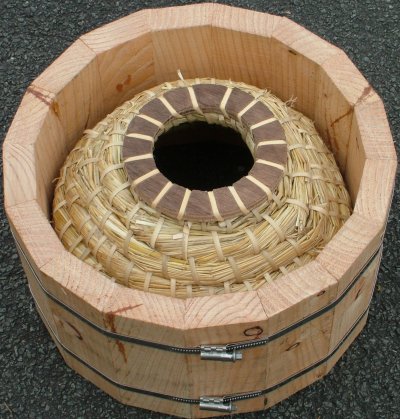
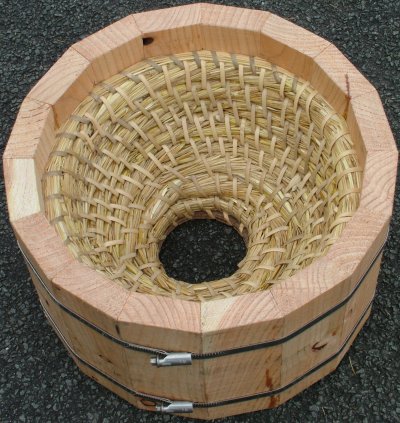
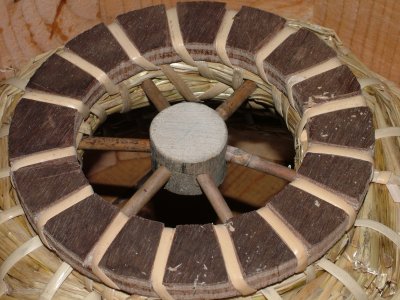
Below left: The stitching technique using a skep needle and gauge (33 mm bore at the narrow end). Each loop of the pre-soaked lapping cane goes through the adjacent loop on the rope coil below. The cane is passed through the hollow in the needle. Presoaked straw is frequently pushed into the wide end of the gauge until it is tight. This is repeated each time the gauge is slid along the rope.
Below right: Home made aluminium skep needle 10 mm OD, 8 mm bore.
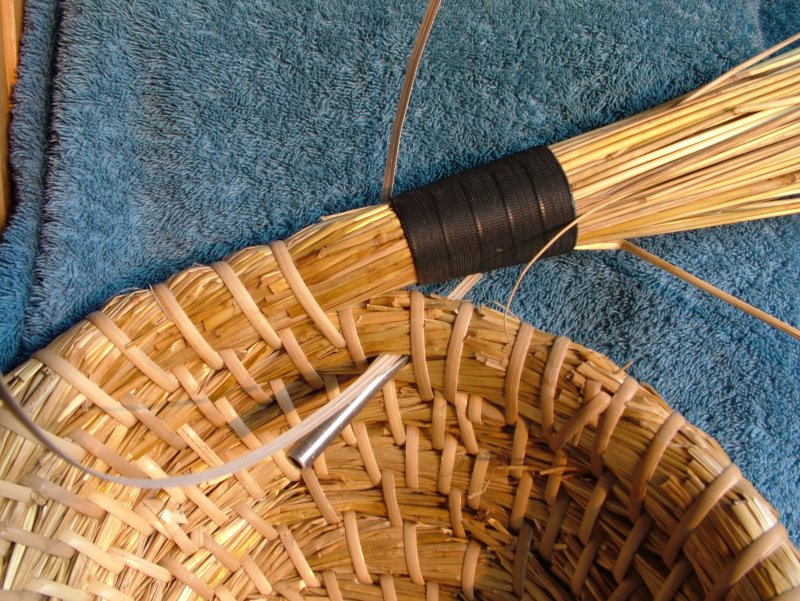

Below left: floor and stand. Below centre:
quilt box with top cloth to cover skep hole.
Below right: Quilt filling in quilt box; filling is electric planer
wood shavings in a linen bag.
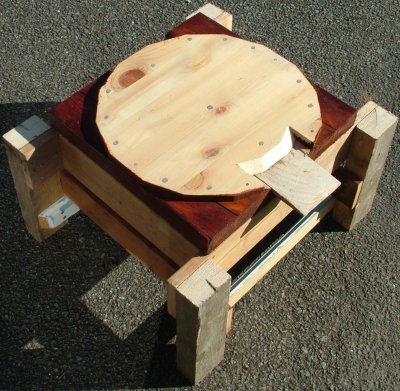
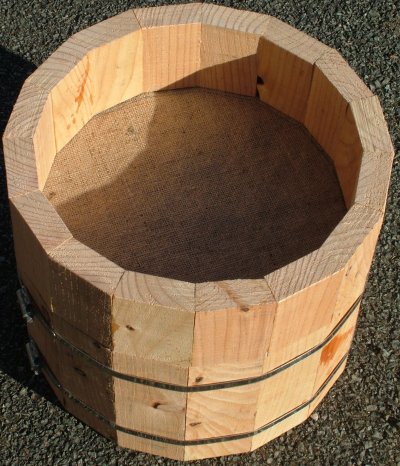
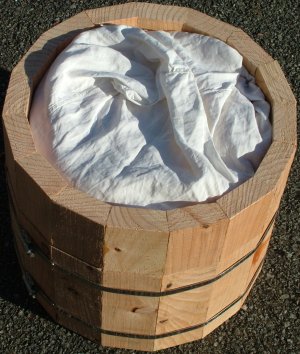
Below left: Quilt box used as super resting on
supering board; will also take Warré quilt box or a full sized Warré box. Roof fits all
three options.
Below centre: View inside from top.
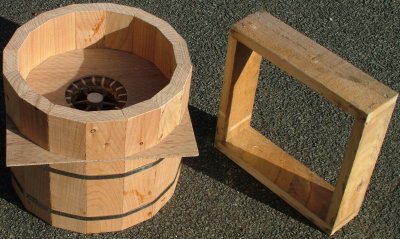
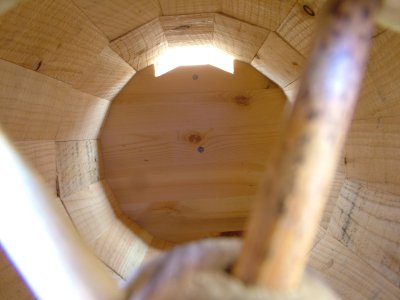
Below left: Small top feeder in place in quilt
box used as an eke. Will also take Warrés Ashforth-type autumn feeder provided supering
board is inserted.
Below right: Completed hive.
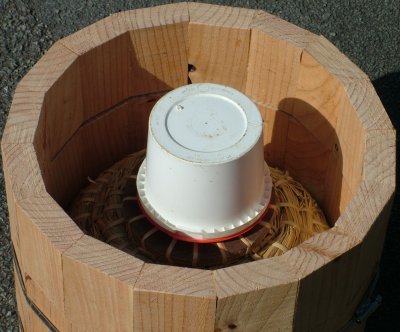
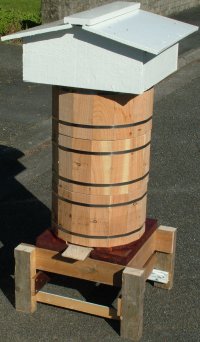
Volumes
Dome 5.4 litres. Volume below dome in dome box 3.2 litres. Volume of domeless boxes 16.6 litres. Total volume of three box hive with the dome in the top box 42 litres. All this volume is available to comb, comb seams and peripheral galleries. The volume available to comb, comb seams and and within-frame peripheral galleries in a National hive is 27.2 litres (frame internal height 191 mm; frame internal width 337 mm, brood box width 422mm).
Populating the hive -- 17 May 2012
A somewhat untidy swarm emerged in the home apiary on 17 May 2012. The bees were scattered over more or less everything in the apiary, including the ground, a sheet of corrugated iron sheltering spare hives and a small sycamore nearby. Some of the bees on the ground were gathered into a small cluster. A stick (left photo below) was pushed into the ground by them as a marker. Returning 45 minutes later, the bees had disappeared from all places except by the stick, where they had formed a column on it (right photo below).
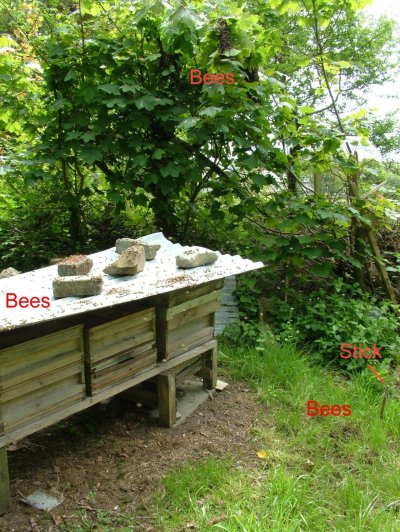
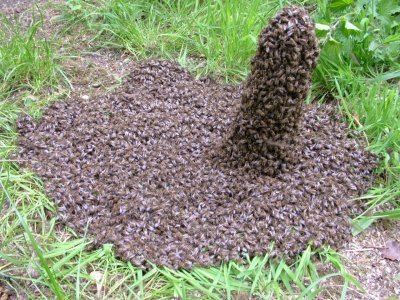
The swarm was hived by placing the upper two boxes over it on suitable supports (below left). The bees entered the box slowly, so a temporary shelter was erected because it was threatening rain. As they were not fully in by 8 p.m. the setup was left until the following morning, by which time most of the swarm was in the top box, and hanging down into the second box where part of the cluster was still on the wall. The photo on the right below shows part of the underside of the cluster, the joint between the two boxes and the bottom rim of the straw dome. The apparent 'dent' in the cluster is most likely where the stick projected into it. When the hive was removed and placed over the third box on its stand, a small cluster of bees remained behind on the stick.
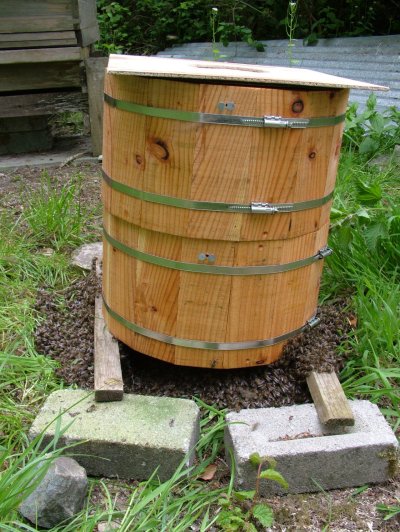
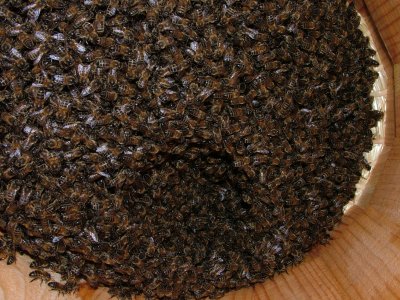
The quilt box, filling and roof were installed and the bees left to orientate to the hive which was about a metre from the swarm landing site.
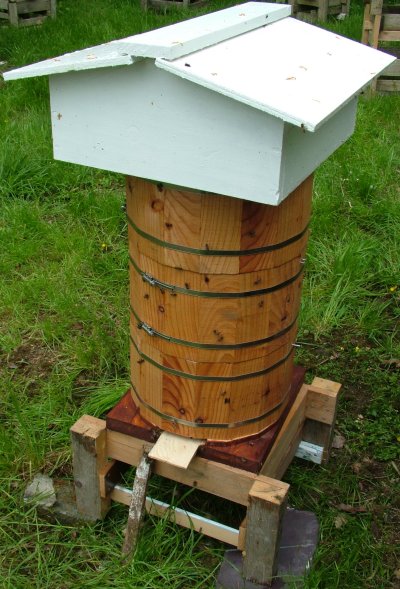
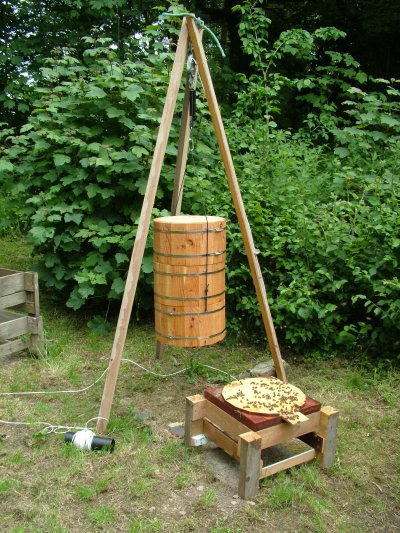
Inspecting and weighing the hive -- 2 June 2012
The hive with 2 boxes, dome, quilt and top-bar cloth weighed 13.1 kg before populating. By 2 June 2012 it weighed 20 kg, a gain of 6.9 kg in 15 days, which includes bees, comb and comb contents. The photo below was taken from underneath the hive and shows that the cluster already reaches into the third box. In some photos the tip of a comb is just visible.
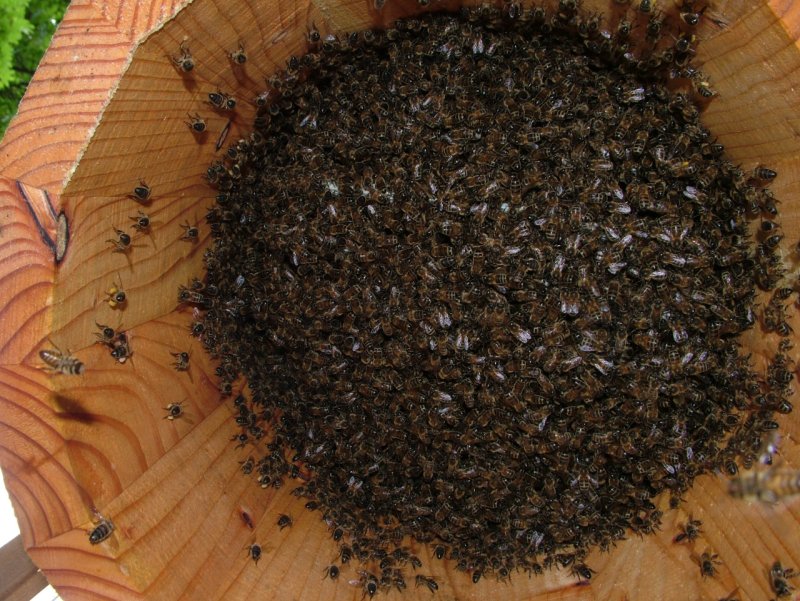
By 11 July 2012 the middle combs reached about 75 mm from the floor, but the edges had barely progressed beyond the joint between boxes 2 and 3. For the photo below, the bees were brushed aside from the bottoms of the central combs. There were many dead Varroa on the floor but no sign as yet of deformed bees. Several other colonies in the apiary are discharging deformed bees, in some cases in the dozens.
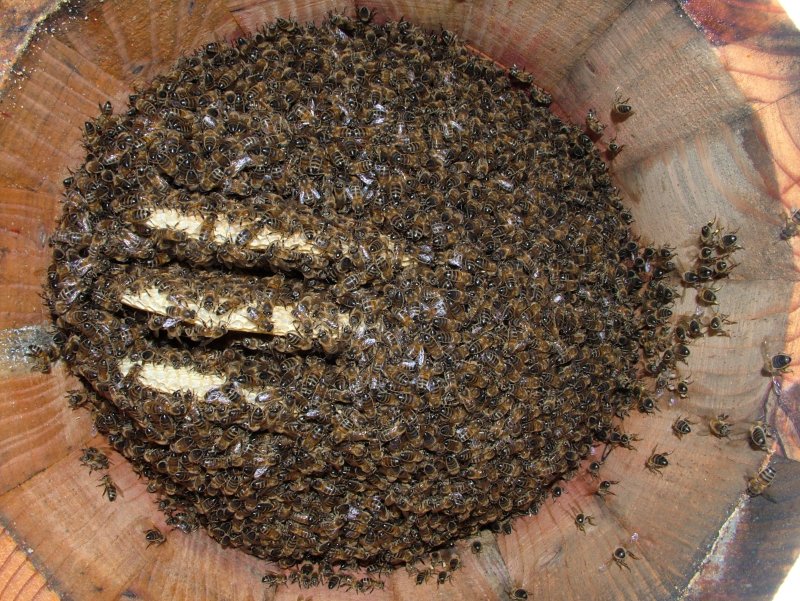 11 July 2012
11 July 2012
The first colony in this hive did not survive the 2012-2013 winter. The hive complete with comb was repopulated with a swarm on 4 June 2013. It built up rapidly and the following month a super comprising a glass dome from a washing machine door was added containing a ladder comb that made contact with the comb in the top of the skep dome.
A second hive was populated on 7 June 2013.
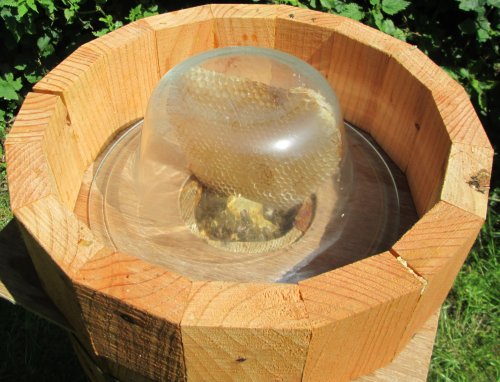 Glass super with ladder comb
Glass super with ladder comb
Although the comb was well covered with bees when examined on 21 July 2013, they stored no honey in it and built no more combs, this despite it being a good season. However, it was a colony started late and it probably concentrated its stores nearer the cluster ready for winter.
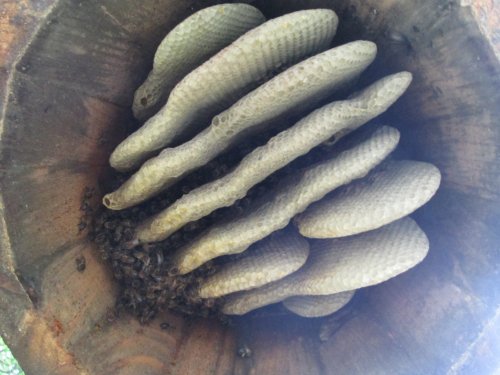 3 October 2013
3 October 2013
By 3 October 2013 the colony had not significantly extended the 2012 colony's combs, and had retreated off the lower regions of them. It weighed 20.6 kg without the quilt. Subtracting 11.5 kg for the hive this leaves a total of 9.1 kg bees, comb and stores. The stores were estimated to be about 7 kg. The colony was fed 2 kg of a sugar/honey mix as thick syrup.
The second colony started on 7 June 2013 weighed 19.7 kg or 8.2 kg after allowing for the hive weight. Stores were estimated to be about 6 kg. This colony was also given a 2 kg honey/sugar feed. It was much slower to take down the feed.
Spring inspection on 24 April 2014
Both colonies came through winter and were foraging well in the spring of 2014. On 24 April 2014 they were both lifted, weighed and photographed.
The first had clearly torn down a lot of comb and carried out some rebuilding, depositing much old, dry comb on the floor. In the left photo below, the torn down comb is in the upper part of the photo and some smaller, new combs appear bleow it. The right photo shows the discarded comb fragments and the comb powder that is a feature of this process. It has been observed in several Warré hives and involves grey, dry comb that has been built in a previous season at the bottom of a colony but has been used neither for brood rearing nor long-term honey storage.
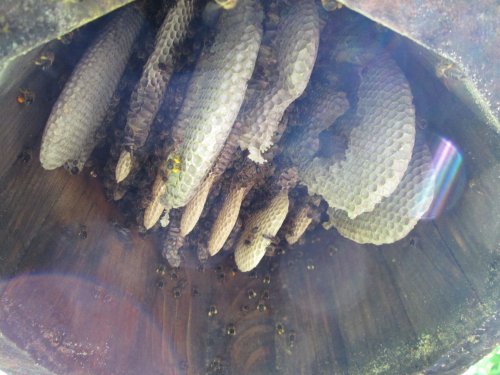
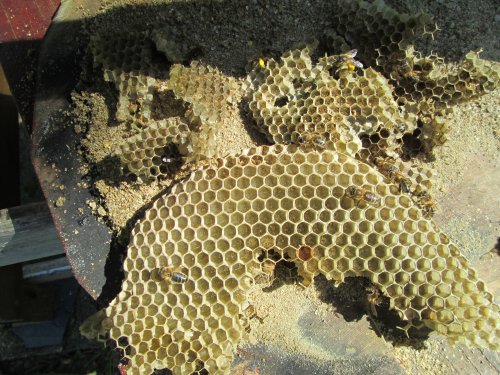 24 April 2014
24 April 2014
The first colony weighed 10.5 kg and the second 9.5 kg after subtracting the hive weight (11.5 kg). The second colony had extended only some central combs into the bottom (third) box.
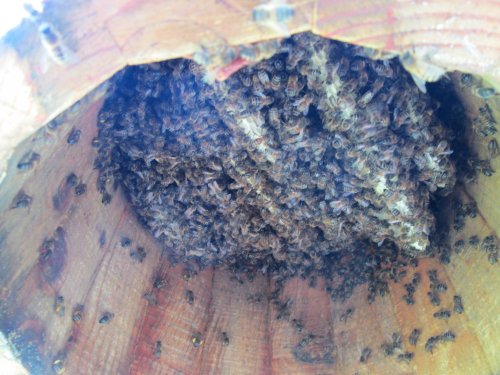 Ruche sauvage 2, 24 April
2014
Ruche sauvage 2, 24 April
2014
The upper part of the propolis entrance restrictor is visible on the top, central stave in the above photo.
22 June 2014
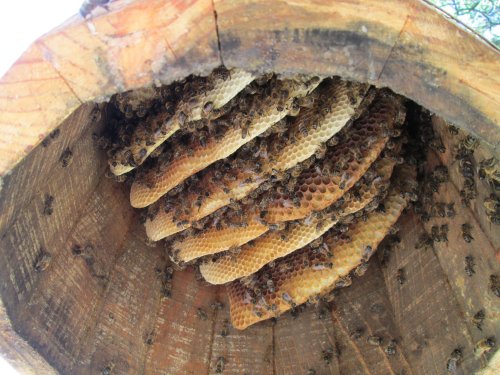 Ruche sauvage 2,
22 June 2014
Ruche sauvage 2,
22 June 2014
No further comb growth occured in the intervening two months. The combs are not so well covered with bees indicating that the colony probably swarmed.
The glass super on ruche sauvage 1 showed no evidence of honey storage.
14 July 2014
The glass super on ruche sauvage 1 was found to be full of honey.
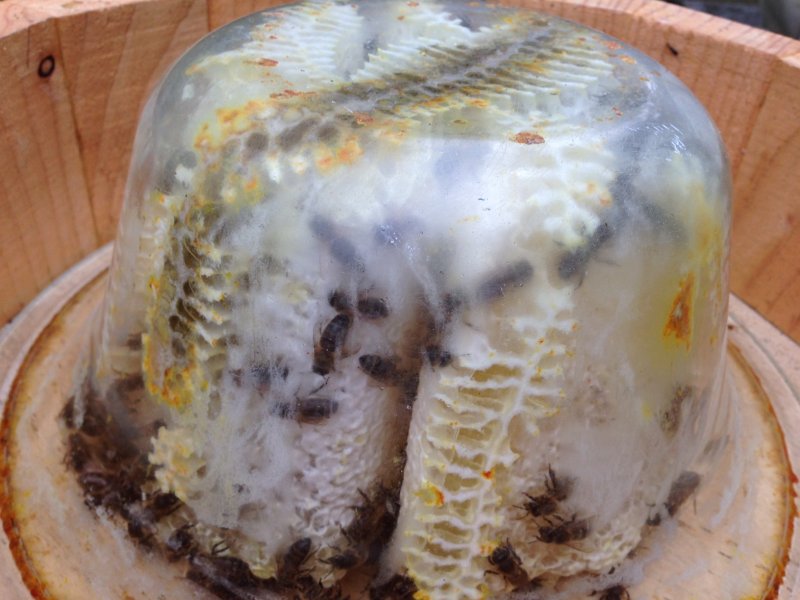 Photo: Trevor Ray
Photo: Trevor Ray
It was harvested by cutting through with a wire and inserting of an 8-way escape board to clear the bees. Spillage of honey from the cut upper surface was minimal. Harvesting was by crush and strain.
Below left: depriving skep dome after cutting off super
Below right: underside of super cut from base board
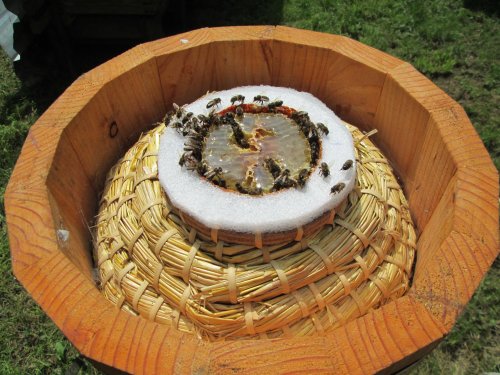
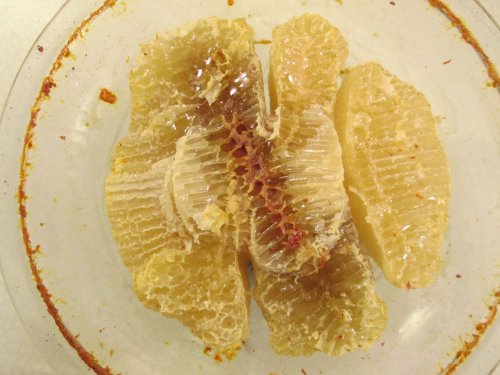
21 September 2014 -- checking prior to winter
Ruche sauvage 2 was found to have a collapsed comb, the bottom part of which was resting on the floor (see below). Comb building had progressed as far as the floor at the middle. The hive weighed 28.3kg of which 14.8 kg was estimated to be honey (hive weight 11.5kg, 2kg for bees, brood and pollen. A super had been placed on this hive but no comb was built in it.
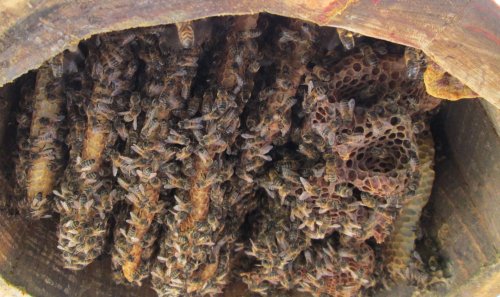
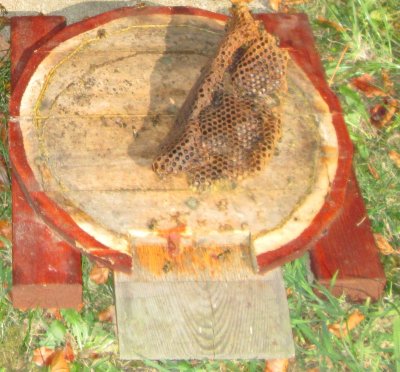
Above left: Ruche sauvage 2 from below. The collapsed comb is right of centre. Above right: part of thecollapsed comb on the floor.
Below: Ruche sauvage 1 (note propolis curtain (top right) near entrance)
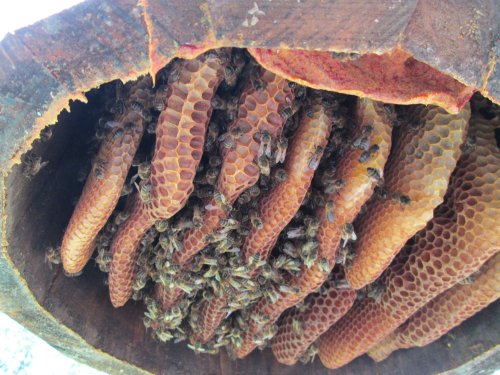
Ruche sauvage 1 weighed 32.1kg indicating it had about 18.6kg of honey. After harvesting the honey from the glass super on this hive, no further comb was built in the glass super.
2 April 2015
Both hives survived the winter. Stores weights were: hive 1 -- 8.3 kg; hive 2 -- 7.1 kg. The glass super was again placed on hive 1 and a shallow hexadecagonal super with a glass lid on hive 2. This super had a board with a 100 mm hole in it to connect with the deprivng skep dome below and the glass lid was covered with insulation under the roof. During the course of the season comb was built in the hive 1 super but not in the hive 2 super. No honey was stored. It was a coool dull, rainy spring/summer and many hives in the locality produced no surplus.
Photos immediately below taken through the glass lid of the super on hive 2.
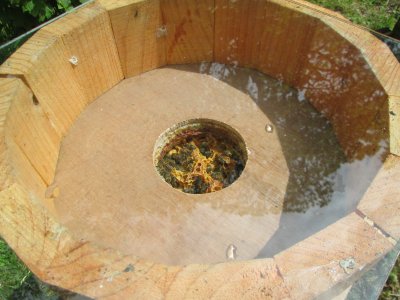
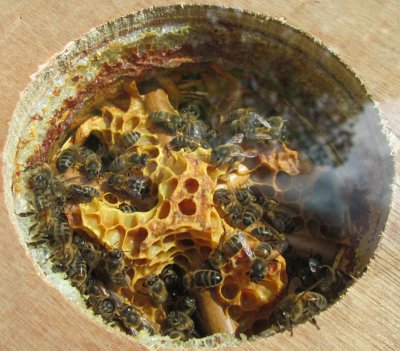
11 September 2015
Weiged both hives and estimated stores. Hive 1 weighed 24.5 kg. Subtracting 11.5 kg for the hive, 2.5 kg for comb and 1.5 kg for bees that left about 9 kg of stores, meaning that this hive did not require feeding. It was foraging normally. Hive 2 weighed 21.7 kg and thus had about 6 kg stores. This hive was fed 3 kg sugar as syrup 2:1 in a contact feeder over the depriving skep hole.
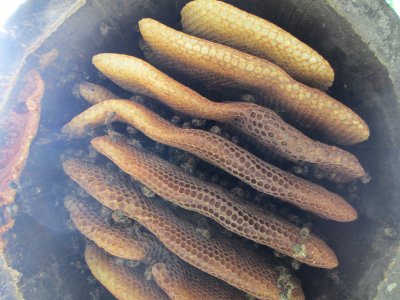 Hive 1
Hive 1 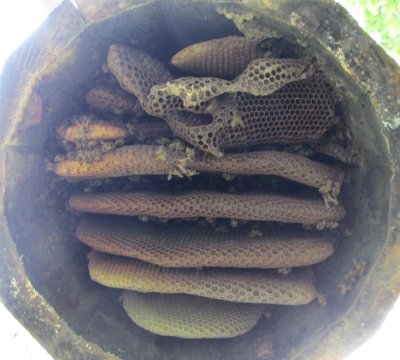 Hive 2
Hive 2
Hive 2 showed very little foraging in late September. Bees stood around on the alighting board doing little more than defending the hive against wasps. Small drones were occasionally seen entering/leaving, possibly from a neighbouring failed National colony that was shaken out in the apiary.
Below left: As the comb reached the floor on both hives, they were both given an additional ring.
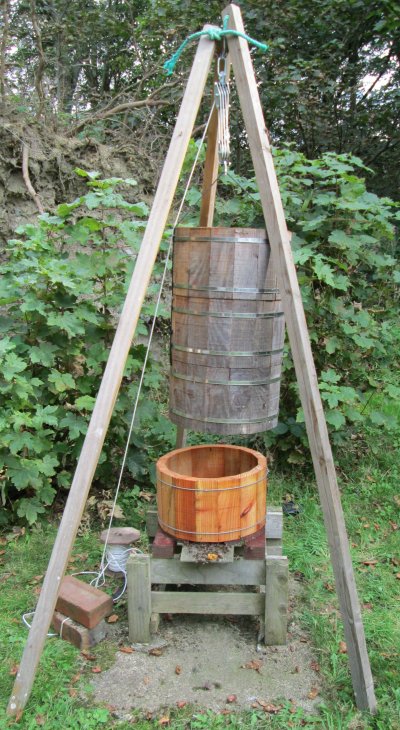
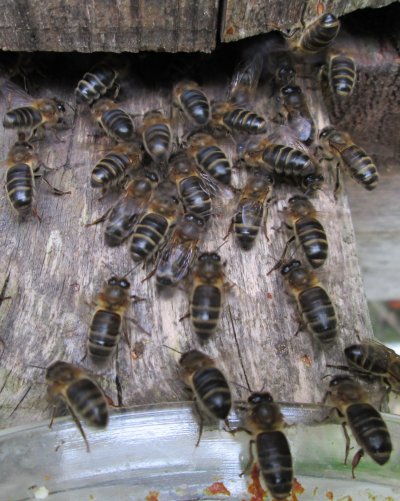
Above right: in driving the bees from the glass super it was noted how extraordinarily black they were.
22 October 2015
Ivy pollen coming in to both hives.
10 March 2016
Pollen coming into hive 1 but not hive to. Comb crumbs at hive 2 entrance and some bee traffic suggestive of robbing. Hive 2 closed up.
12 May 2016
Supered hive 1 with glass super containing ladder comb as before.
12 June 2016
Hive 1 foraging normally but less than some other hives in the apiary. No bees in the super yet despite excellent weather and massive nectar flows in May.
Hive 2 dismantled: the dome ring was cut off with a bread knife.
Left: underside of dome ring after cutting with knife Right: top of ring 2
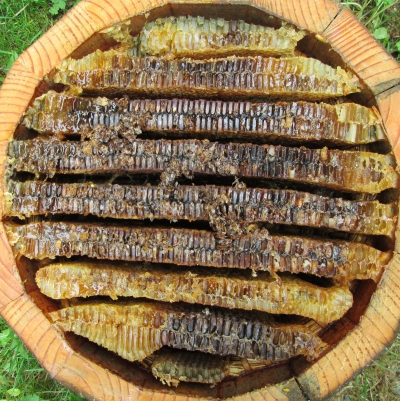
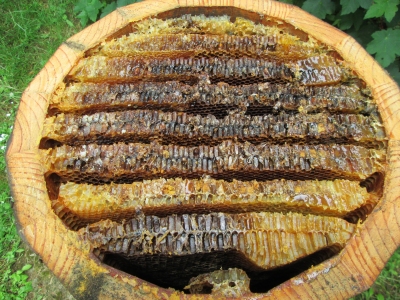
The combs in rings 2 and 3 were cut from the walls with a Warré comb knife.
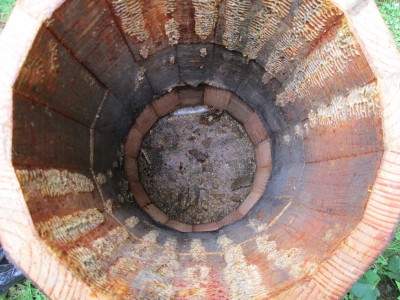
Below: sequence of combs (tops cut between the dome ring and ring 2)

Combs were cut from the dome with an L-shaped piece of 4 mm fencing wire with the base of the 'L' hammered flat and sharpened into a blade. The job would have been easier with a skep knife designed for the purpose.
Left: first piece of dome comb removed Right: most of dome comb removed
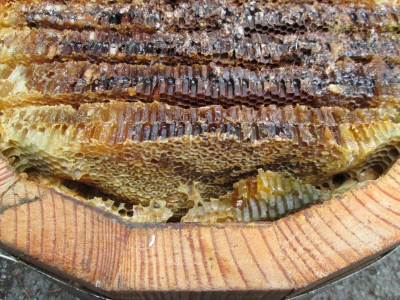
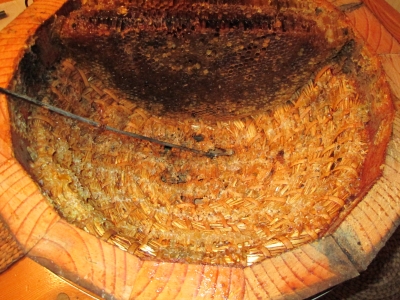
The height of the central combs was 577 mm. The average comb spacing was 34.7 mm. The average worker cell size measured both sides in the lower third of 7 combs was 5.2 mm (range 5.0-5.35 mm). About 3.5 kg honey was recovered.
Spring/Summer 2017
Hive 1: Pollen was coming in through March and April but by 12 May, foraging traffic was looking weak. Pollen was seen going in on 20 May but foraging had dwindled to almost nothing by 13 June. On 22 July 2017 the hive was being robbed so was dismantled. The circular brood area on the long combs is clearly visible in the photos below (darker zones).
Below left: Hive 1 top box and combs inverted Below right: Hive 1 top box with three combs removed.
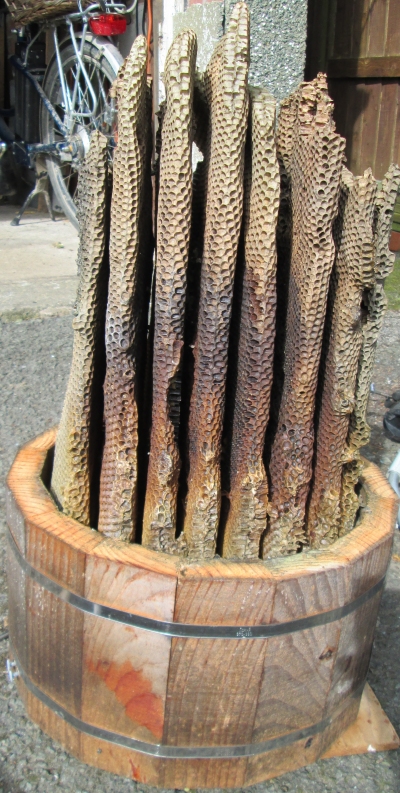

John Haverson's version of Claude Bralet's 'ruche sauvage'